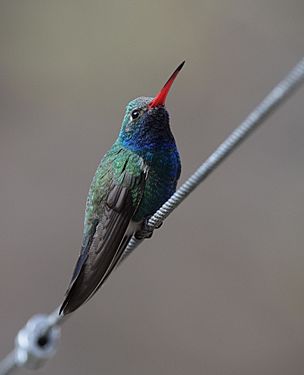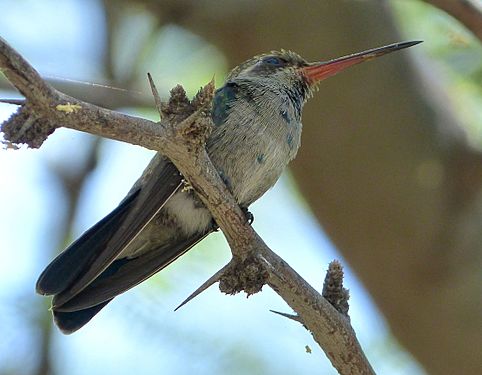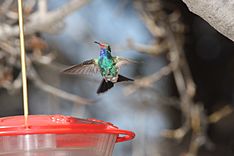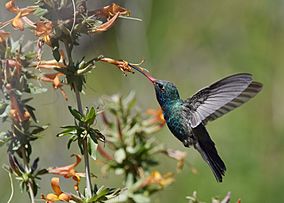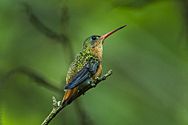Broad-billed hummingbird facts for kids
Quick facts for kids Broad-billed hummingbird |
|
|---|---|
 |
|
| Conservation status | |
| Scientific classification | |
| Genus: |
Cynanthus
|
| Species: |
latirostris
|
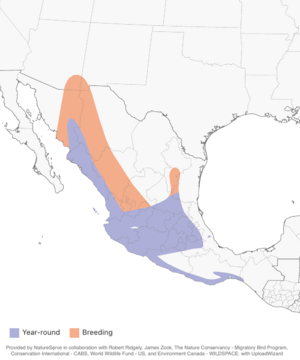 |
|
The broad-billed hummingbird (its scientific name is Cynanthus latirostris) is a small, colorful bird. It lives in Mexico and the southwestern United States. Male and female broad-billed hummingbirds look different. Young birds, called juveniles, look more like the adult female. This hummingbird is known for its wide, bright red beak. People also call it Colibrí Pico Ancho in Spanish and Colibri circé in French. These birds are mostly active during the day.
Contents
About Broad-billed Hummingbirds
There are about 360 different kinds of hummingbirds in the world. Scientists group them into 9 main families. The broad-billed hummingbird belongs to the "emerald clade" of hummingbirds. This group formed between 10 and 15 million years ago. It has the most types of hummingbirds.
A scientist named William Swainson first officially described the broad-billed hummingbird in 1827. He used birds collected by William Bullock in Mexico. Swainson gave the bird its two-part scientific name, Cynanthus latirostris. The name latirostris comes from Latin words. Latus means "broad" and -rostris means "-billed."
Different Types of Broad-billed Hummingbirds
Scientists recognize three main types, or subspecies, of the broad-billed hummingbird:
- C. l. magicus: Found in the southwestern USA and parts of northwest Mexico.
- C. l. propinquus: Lives in central Mexico.
- C. l. latirostris: Found in eastern Mexico.
These groups of scientists used to include two other types. These are now known as separate species. They are the Tres Marias hummingbird and the turquoise-crowned hummingbird.
Sometimes, broad-billed hummingbirds can have babies with other hummingbird species. This is called hybridizing. They have been known to hybridize with the Rivoli's hummingbird and the Violet-crowned hummingbird.
What They Look Like
The broad-billed hummingbird is a small bird. It is about 8 to 10 centimeters (3 to 4 inches) long. It weighs only 3 to 4 grams. That's about as much as two paper clips! Males are usually a little heavier than females. Their wingspan is about 13 centimeters (5 inches).
They have a long, bright reddish beak with a black tip. Their backs are metallic green. Their heads and foreheads are a bit duller green. Male and female broad-billed hummingbirds look quite different. This is called sexual dimorphism.
The male broad-billed hummingbird is dark green. It has white feathers under its tail. Its throat is blue. The adult male's tail is wide and bluish-black. Its flight feathers are brownish-gray.
The adult female has a pale belly. She has a white stripe behind her eye. Her tail feathers have white tips. The male's beak is shorter but brighter red than the female's. Both young and adult males have larger wings and tails than females.
Young broad-billed hummingbirds look like the adult female. As young males grow, their beaks turn redder. Shiny feathers appear on their throats. Unlike females, young males do not have white-tipped tails.
Baby hummingbirds, called hatchlings, have brown bodies. They have orange fuzzy feathers and an orange beak. Not much is known about them. But in captivity, young birds get their adult feathers in 6 to 8 months.
What They Sound Like
Both male and female broad-billed hummingbirds make a chattering sound. It sounds like a fast chi-dit. They can make this noise while sitting or flying. The male's special call to attract a mate is a whining zing.
Where They Live
In the United States, broad-billed hummingbirds live near streams and in oak forests. They like places with thick plants near streams. They also like open oak forests in lower canyons. They often live near Arizona sycamore, Fremont cottonwood, and mesquite trees.
In Mexico, these birds have been found at many different heights above sea level. They can live from sea level up to 3,048 meters (10,000 feet) high. Along the Pacific coast, they are common in dry thorn forests and tropical forests.
During breeding season, you can find broad-billed hummingbirds in desert canyons. They also live in low mountain oak forests. They are found from the southwestern United States down to central Mexico. They have been seen breeding in Arizona, New Mexico, and sometimes in Texas. They have also been rarely seen in other states like Arkansas. In Sonora, Mexico, they are the most common hummingbird.
Traveling Birds
Broad-billed hummingbirds that live in the United States, Sonora, and Nuevo León usually migrate. This means they fly south for the winter. Scientists believe they fly deeper into Mexico. Most broad-billed hummingbirds in Mexico stay in one place all year. The ones in the far north of Mexico migrate south in early November. They return in early March. Sometimes, they are seen in unusual places. These include Southern California, Texas, Oregon, Idaho, Colorado, and even the East Coast.
How They Live
What They Eat
Broad-billed hummingbirds eat both nectar from flowers and insects. They also visit sugar-water feeders that people put out for hummingbirds. They seem to like red or red-and-yellow flowers the most.
To drink nectar, the hummingbird puts its long beak and tongue into the flower. It hovers in the air while it drinks. But at feeders, they often perch (sit) while they eat. To catch insects, they can grab them while flying. Or they can hover and pick them off plants.
In the United States, broad-billed hummingbirds eat from many types of flowers. These include Agave, desert honeysuckle, milkweed, Bouvardia, bird-of-paradise, Indian paintbrush, desert willow, New Mexico thistle, fireweed, coral bean, ocotillo, trumpet honeysuckle, scarlet bugler, Mojave beardtongue, superb penstemon, and Texas betony.
In southern Mexico, they eat from flowers like Bejuco blanco, pochote, cactus, fairy-duster, Bumelia species, and liana.
In some parts of Mexico, broad-billed hummingbirds live in the same areas as Cinnamon hummingbirds. This means they compete for food. When they compete, broad-billed hummingbirds might eat from flowers that have less nectar. They usually prefer flowers with lots of nectar. These include sharpleaf jacaranda, sleeping hibiscus, and mistletoe. But when competing, they might eat from Calopogonium parvum, royal poinciana, velvet-seed, hibiscus, and coralblow.
In central Mexico, broad-billed hummingbirds eat from two types of cacti. After eating, they sometimes have pollen on them. But scientists don't think they help these plants spread their pollen.
Not much is known about broad-billed hummingbirds eating insects. One study showed that even when there are many insects, the hummingbirds prefer flowers if they are available. In one area of Mexico, they were only seen eating flying flies and mayflies.
How They Breed
Broad-billed hummingbirds choose their mates. To attract a female, the male performs a special "pendulum display." He hovers in front of the female. Then he flies back and forth four times in arcs, like a swinging pendulum.
In the United States, they usually try to have two sets of babies each year. The first is from mid-April to late June. The second is from July to mid-August. These times are when there is a lot of nectar available in their homes. In Arizona, pairs breed in open areas at heights of 914 to 1,524 meters (3,000 to 5,000 feet). In southern Mexico, they breed for a long time, from January to August.
Broad-billed hummingbirds usually build their nests within 2 meters (about 6.5 feet) off the ground. In one study, most nests were about 1.1 meters (3.6 feet) high. Females build the nests all by themselves. They weave nesting materials like bark, grasses, and dried leaves. They shape the nest with their bodies. The nest is about 2.5 cm (1 inch) tall. The inside is about 1.9 cm (0.75 inches) wide. The inside is lined with soft materials like plant fuzz, stems, leaves, and even lichen.
Once the nest is ready, the female lays two smooth, white eggs. On average, the eggs are 12 by 8 millimeters (about 0.5 by 0.3 inches). Scientists believe the female sits on the eggs for more than two weeks. After the babies hatch, the female spends about 60% of her time at the nest. The biggest reasons why nests fail are predators eating the eggs or babies, or the mother leaving the nest. Sometimes, the eggs just don't hatch.
Scientists are still learning about how long the eggs take to hatch, how the babies grow, and when they leave the nest.
Images for kids
See also
 In Spanish: Colibrí piquiancho para niños
In Spanish: Colibrí piquiancho para niños



